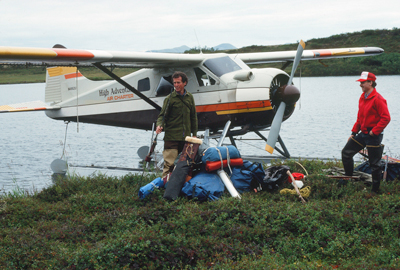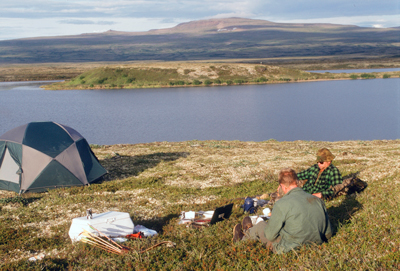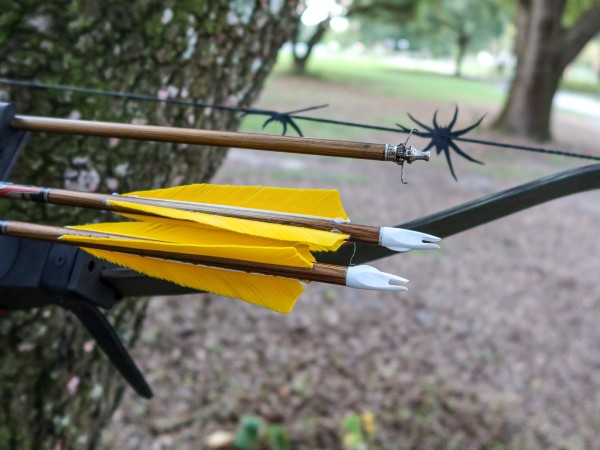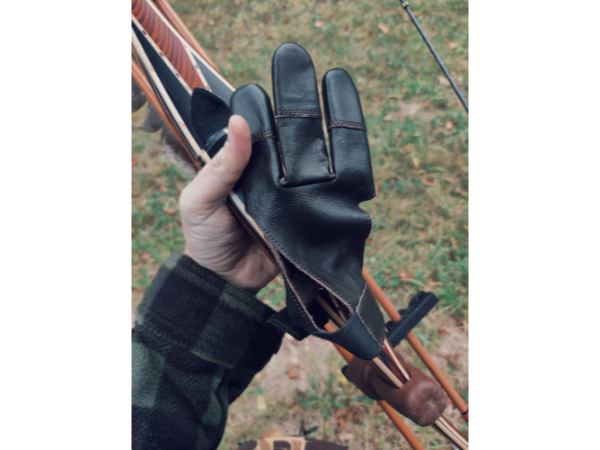I have no idea how many nights I’ve spent camped out in the field, but it’s a lot. Most of them were pleasant and highly enjoyable, either because I was engaged in exciting hunting or fishing nearby or simply because my surroundings were free of the noise and clutter of daily life closer to civilization. There were exceptions, however, and they often arose simply because I’d made a poor decision when it came time to choose a campsite.
A number of factors commonly influence that decision, including the season, weather, the purpose of the trip, and the amount of gear weight limitations allowed you to bring along. While it would obviously be impossible to cover all such situations here, a number of principles apply whenever it comes time to select a spot to camp, whether you’re planning to stay for a night or a month.
The most important consideration should usually be protection from the elements. Erecting a tent on an open promontory might provide a wonderful view and a convenient opportunity to glass for game while you’re cooking or lounging around camp, but such exposed campsites leave you—and your tent—vulnerable to the wind. Sudden gusts associated with thunderstorms or the sustained winds that are so common in places like Alaska can flatten even the best designed tents quickly. In a worst-case scenario, they can even blow a light backpacking tent away completely, perhaps taking your sleeping bag and extra clothing along with it.
Having spent a few nights inside tents with broken poles that left soggy fabric hanging just above my face, I now do my best to set up my tent in a location sheltered by trees. Camping in the alpine above the tree line or on open tundra or prairie, this may not always be possible, but whenever I can exercise this option, I will. This also provides an opportunity to tie the tent down to something solid, like tree trunks or branches—an important consideration given that tent stakes alone won’t always hold a tent down securely in high winds. Even if poles do start collapsing, a tent tied down securely in timber won’t go far.

If you are arriving by boat or floatplane, you’ll want to camp near a beach free of rocks, with water depth sufficient to float the craft but shallow enough to wade while loading and unloading.
If you’re in a location with no trees available, at least try to pitch your tent down in a depression where it won’t be exposed to the brunt of the wind. Before leaving the subject of wind, I should point out that it can actually be your friend early in the season when the bugs are bad. If mosquitoes seem more likely than wind to ruin your night, break the rule and pitch your tent in an exposed area.
Moisture is the second major environmental consideration. Rain is rain and there’s not much you can do about it, although camping beneath a thick evergreen canopy can lessen its impact on your tent fly. Moisture at ground level is more likely to pose a problem, since not even the best ground cloth can hold it off indefinitely. Furthermore, camp cookery in mud just isn’t much fun. I always look for a well-drained surface before pitching my tent.
On the many extended wilderness float trips I’ve made, gravel bars always offered attractive campsites, with level ground, ready access to drinking water, and short distances to carry bulky gear from rafts. However, the late Jay Massey, who had plenty of experience with the subject, always cautioned against those easy gravel bar campsites because of potential rises in water level from the river. He pointed out, correctly, that in long mountain drainages rivers can rise quickly because of upstream rainstorms even when weather is clear at the proposed campsite.
I learned my lesson about camping on gravel bars at the end of one long September float for caribou years ago. A hunting partner and I had been on a Southwestern Alaska river for nearly two weeks when a deluge struck. When we reached the straight stretch where we were scheduled for pickup by floatplane the following day, we packed our gear up to the base of a steep bluff and set up our tents. By the time we realized how quickly the water was rising, daylight was starting to fade, and we had to break camp down and pack everything, including the rafts, up the bluff in the dark.
We awoke the following morning to see the spot where we first camped covered in running water. The river was so high that our pilot had to remain in the current jockeying the throttle while we loaded our gear into the Beaver. Had we gone to sleep where we first camped, we could have lost all our gear and possibly drowned. While gravel bar campsites are still too tempting for me to pass up routinely, I always insert a stick in the sand at the water’s edge to monitor changes and check it carefully before heading for my sleeping bag.
Most campsite selection factors pertain more to comfort than survival, but they’re still important, as anyone who has tried to stay sharp during a long day of hunting after a sleepless, miserable night knows. While no one enjoys sleeping on a rockpile, the simple presence of level ground may be a more important consideration than its consistency. Even on an accommodating surface like sand or tundra, it’s amazing how much a few inches of tilt can interfere with sleep. You and your sleeping bag will inevitably end up in a ball on the downhill side of the tent. If you are pressing against the side and the fabric is wet, moisture may wick in and leave you with a damp sleeping bag. It’s always worth spending a little extra time to search for the flattest ground around before pitching your tent.

Caribou hunting often means camping on open tundra offering little protection from the wind. During the early season, bugs can be an even bigger problem, so stake out as well as you can and hope for the best.
No matter whether the problem is a minor slope or a rock you haven’t noticed, the only way to ensure that a surface will provide a comfortable night’s sleep is to give it a test drive by lying down on it. Even this simple act can turn into an adventure. One September evening in central Montana, I was setting up a simple one-man camp in preparation for an elk hunt the following morning. I planned to sleep in a lightweight, free-standing backpack tent, which I set up and began to move around to different locations. When I found one that I liked, I crawled inside and lay down to see if the spot would be as comfortable as it looked. As soon as I stretched out on my back, I felt something soft move underneath the tent floor. I jumped out of the tent, picked it up, and saw that I’d placed my tent right on top of a prairie rattlesnake as thick as my arm.
Proximity to certain natural resources can be another important consideration in campsite selection. Water is the most important, because it’s the one you can’t do without. In a desert environment, proximity to potable water may trump all other considerations, but lack of water can surprise you in other places, too. Water can be scarce in alpine sheep and goat country and may require you to melt snow, which can waste a lot of fuel. I once landed on a beach in Alaska and nearly had camp set up before I realized that high tides required hiking a mile up the nearest creek to find fresh water. I could have avoided the problem by landing closer to a freshwater pond above the high tide line.
Seasonally, firewood can be another important factor in campsite selection. Nothing makes elk or moose camp more comfortable than a small woodstove in a wall tent, assuming an adequate supply of fuel. Another advantage of camping in or near trees is the ability to hang game off the ground where air can circulate around it and bears will have more trouble reaching it. (I didn’t say can’t reach it, because a determined bear can perform amazing feats in the pursuit of a moose quarter.)
And speaking of bears, it’s important to avoid areas of high bear concentration. When bears are feeding on salmon during summer and early fall, they establish virtual highways along the stream banks, which make ill-advised campsites as the late Timothy Treadwell found out the hard way. I’ll always go to the extra effort needed to make camp up on the tundra well away from salmon streams. Berry patches with evidence of recent bear activity should be avoided for the same reason. This is an opportune time to mention the use of lightweight portable electric fencing to help keep bears out of your camp. The Alaska Department of Fish and Game offers excellent information on the subject at adfg.alaska.gov.
If you have reached the area you plan to hunt by means other than backpacking, your mode of transportation may influence your choice of campsites. Horses are a great way to get heavy loads of elk or moose out of the backcountry, but they will require a constant source of water and some open areas for grazing. Since horses always seem to find ways to get in trouble, I always liked to camp as close to mine as possible. If you have arrived by floatplane or skiff, you’ll want to camp near a protected shore away from wind and waves, with a gradually sloping gravel beach to facilitate loading and unloading.
The difference between a good camp and a bad camp can define the difference between a good hunt and a bad hunt (if there is such a thing), and it begins with the selection of the campsite. I’ve spent some nights in miserable ones—buffeted by wind, engulfed in mud, far from the nearest source of water. I’ve spent far more time in camps so pleasant that I’d gladly return to them for a week or two even if hunting seasons were closed. Over the decades I’ve learned that the more time I invest in the details of campsite selection, the more likely the camp is to fall into the second category.
Co-editor Don Thomas has spent seven decades camping out all over North America, especially in Alaska and the Mountain West, giving him plenty of opportunity to learn from his mistakes. His books on various outdoor subjects are available at donthomasbooks.com and most on-line book outlets.







Leave A Comment